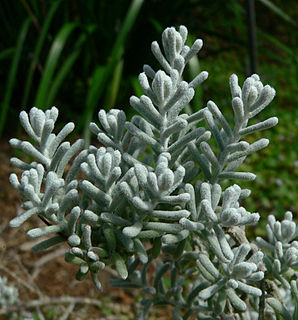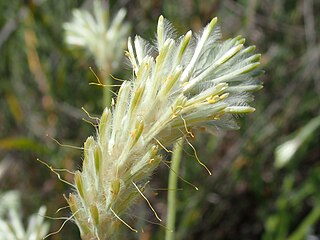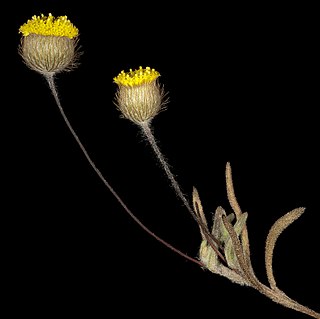
Maireana sedifolia, also known as the bluebush or pearl bluebrush is a compact shrub endemic to Australia, and found in New South Wales, Victoria, South Australia, Western Australia, and the Northern Territory. It is used in pasture and as a garden plant where it is popular due to its distinctive grey foliage.

Seringia integrifolia is a shrub of the family Malvaceae native to inland Australia in New South Wales, South Australia, Western Australia, Queensland, and the Northern Territory.

Ptilotus manglesii, commonly known as pom poms is a herb native to Western Australia. The Noongar name for the plant is mulla mulla.

Calandrinia corrigioloides is an annual herb in the family Montiaceae, and is native to Western Australia, South Australia, and Victoria.

Newcastelia cephalantha is a species of plant belonging to the mint family, Lamiaceae, and native to several Australian states: Queensland, South Australia, Western Australia and the Northern Territory

Ptilotus pyramidatus, the pyramid mulla mulla, is a small white herb in the family Amaranthaceae.

Sida spenceriana is a small plant in the family Malvaceae found in Queensland, the Northern Territory and Western Australia

Dampiera candicans is a plant in the family Goodeniaceae, native to Western Australia and the Northern Territory.

Ptilotus polystachyus is an herb in the Amaranthaceae family.

Ptilotus schwartzii is a grass-like plant in the Amaranthaceae family.

Ptilotus divaricatus is a shrub in the Amaranthaceae family.

Asteridea chaetopoda is a species of herb in the Asteraceae family, which is endemic to Western Australia, in the south-west. It was first described in 1876 as Athrixia chaetopoda by Ferdinand von Mueller, and allocated to the genus, Asteridea, in 1980 by G. Kroner. It is a perennial herb, growing on sandy soils, on limestone and on gypsum, to heights from 5 cm to 30 cm. Its yellow flowers may seen from August to November on salt lakes, stony rises, and dunes of Beard's Eremaean and South-West Provinces.

Asteridea athrixioides is a herb in the Asteraceae family, which is endemic to Australia, and found in Western Australia, South Australia and Victoria. It was first described in 1853 by Otto Sonder and Ferdinand von Mueller as Panaetia athrixioides, who described it from specimen(s) collected in the Port Lincoln district. In 1980, G. Kroner assigned it to the genus, Asteridea, giving it the name Asteridea athrixioides. It is an annual herb, growing on calcareous, sandy or clay soils to heights of from 5 cm to 20 cm. Its yellow flowers may seen from July to November on saline on allvial flats, rocky hills and undulating plains.
Asteridea croniniana is a herb in the Asteraceae family, which is endemic to Western Australia. It is an annual herb, growing to a height of 8 cm.

Commersonia craurophylla is a species of flowering plant in the family Malvaceae and endemic to Australia. It is a hairy-stemmed shrub. The leaves have entire margins, and are covered in both simple and stellate hairs.

Pembertonia latisquamea is a species of daisy (Asteraceae), native to Western Australia. It was first described by Ferdinand von Mueller in 1878 as Brachyscome latisquamea and transferred to the genus, Pembertonia in 2004 by Philip Short.

Phlebocarya filifolia is a plant in the Haemodoraceae family, native to Western Australia.

Chenopodium preissii is a plant in the Amaranthaceae family, native to Western Australia and South Australia.

Lachnostachys eriobotrya is a plant in the Lamiaceae family, native to Western Australia.

Hybanthus floribundus is a plant in the Violaceae family, found in southern Western Australia, southern South Australia, Victoria and southern New South Wales.



















